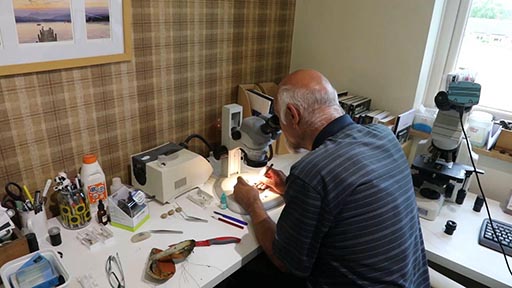2 Using microscopes
As discussed in Week 3, there are many different species of fungi but they are often difficult to tell apart because they have few easily observed characteristics. For example, globally there are over 700 species of Russula mushroom, most of which look rather similar except for the colour of the cap, and even this one character is not ideal since the colour can change over time and can be affected by rain. In the search for more characters to tell species apart, mycologists examine fungi under the microscope to look for aspects of structure that are consistent within a species but differ between species. Examples of these characteristics include the shape of cells on the gill edge and the size, shape and ornamentation of the spores.
Now watch nature enthusiast and iSpot user Flaxton explain aspects of fungal identification, firstly just from observations, followed by demonstrations using different types of microscopes.
In Video 1 Flaxton goes through the process of identifying a Boletus luridus fungi, first by noting how to look for the defining characteristics one can spot first from observation, examining the species with the eyes.

Transcript: Video 1
In this video Flaxton demonstrates how to use a binocular microscope to examine a fungi more closely. This type of microscope is often used to prepare sections of fungi or other small specimens, to help to make them more suitable for viewing under a high-power microscope.

Here we zoom in to better see Flaxton using the binocular microscope as he prepares thin sections of a Russula mushroom cap which is being cut so that cells on the gill edge and spores can be seen.

Using a high-power microscope, Flaxton now examine the Russula species that was shown being sectioned under the binocular microscope. Flaxton demonstrates the microscope being focussed by eye and hand. He then places a camera into one of the eyepieces to show the view from the microscope on the computer screen. Flaxton notes that he is concentrating on just one spore from the mushroom and this shows the shape of the spores by switching to the highest power magnification (1000x). At lower magnifications the spore only showed up as a dot in the field of view but as he focusses up and down different parts of the spore become sharp.

Transcript: Video 4
In this final video clip Flaxton wraps up this section by discussing how to use the techniques demonstrated to help identify the characteristic differences and / or similarities of similar species. He looks again at at his earlier identification of a Boletus luridus fungi. And compares it with Boletus mendax. Flaxton shows the spore size and shape on screen while discussing how to differentiate between the two closely related species.

Transcript: Video 5
There are various types of optical microscope. You may need to use two in combination, one to dissect and prepare the sample and another to examine the dissected sample at high power (Figure 3). While the wavelength of light limits the useful maximum magnification that can be achieved from an optical microscope, much greater magnification can be obtained with electron microscopes. However, sample preparation for viewing with an electron microscope can be difficult and they are very expensive.
The dissecting microscope typically offers a range of magnifications, from about 5x to 50x. With this device, illumination is supplied from above, and some models provide a digital output of images in addition to stereo eyepieces. It is suitable for looking at organisms such as mosses and invertebrates and can also be useful for preparing sections of fungus for examination under a higher-powered microscope. As the name suggests, the dissecting microscope is often used when teasing apart tissue with a needle and scalpel so that you can clearly see the fine details of, for example, individual moss leaves.
Another type of microscope – the conventional compound microscope – offers magnifications from around 100x to 1000x. With this device, illumination is usually supplied from below to shine through the specimen. Like the dissecting microscope, it can supply optical or digital output. The higher magnifications (400x–1000x) may require the use of a high-quality oil immersion lens to give a good image. As mentioned earlier, there is a physical limit to amount of magnification that can be obtained using light due to diffraction. The smallest item that can be resolved using a conventional light microscope with high-power lenses is around 0.0002 mm. Fungal spores are in the region of 0.002 mm to 0.01 mm in diameter, so not only are they visible under the microscope but it is also possible to detect surface ornamentation.
It is possible to attach a digital camera to the microscope and view images on-screen. Once calibrated, this can also superimpose a scale or grid on the image.

